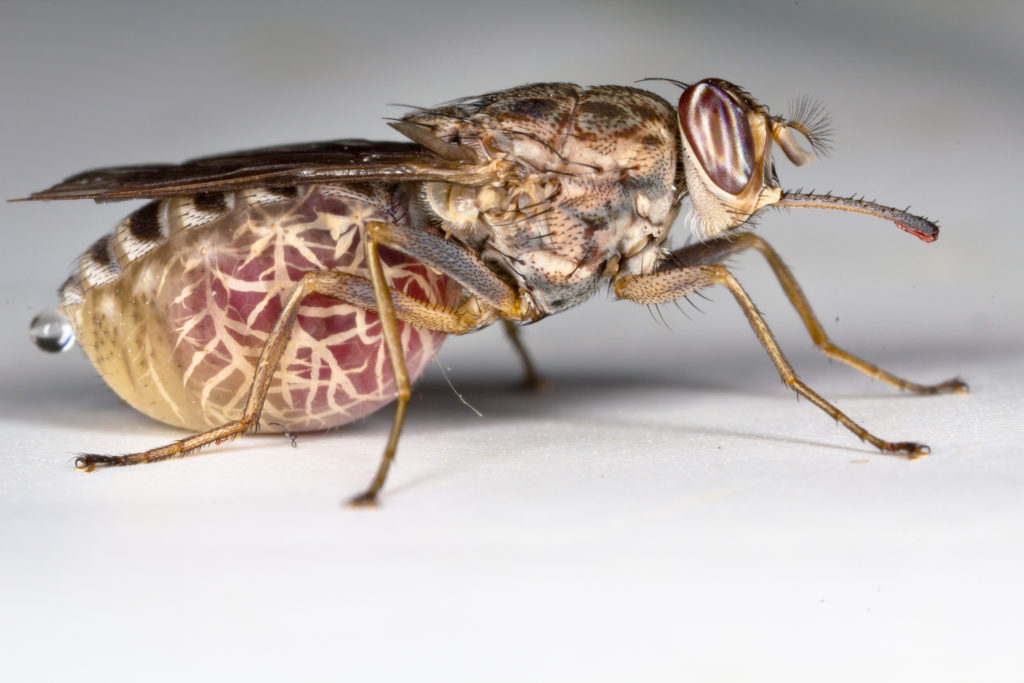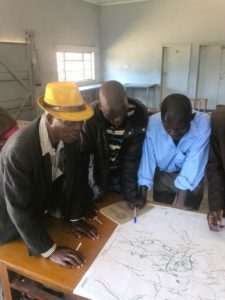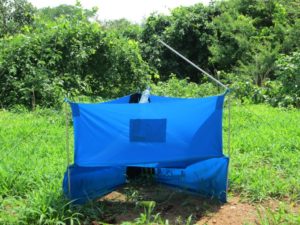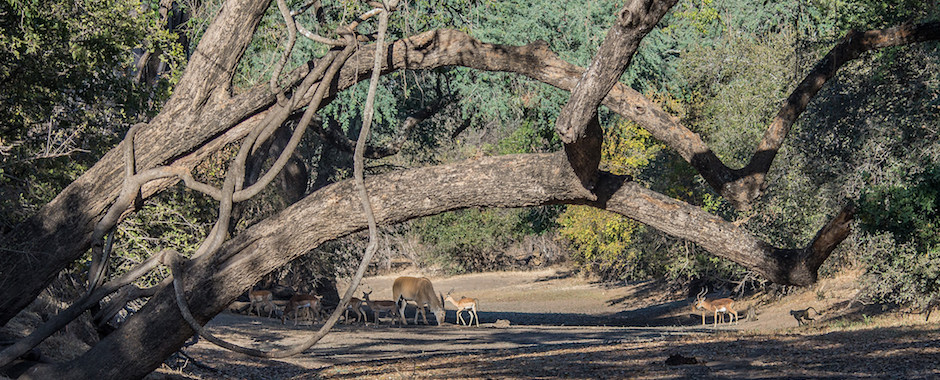Just out in Human Ecology is a new paper – People, patches and parasites: the case of trypanosomiasis in Zimbabwe. It’s open access, so do have a look! It presents the results of a project looking at the socio-ecology of disease in Africa – part of the Dynamic Drivers of Disease in Africa Consortium – which has had a number of other recent outputs linking social and natural sciences in the investigations of disease dynamics in Africa.
The Zimbabwe work started with a puzzle. Why was it that after nearly a century of control efforts, tsetse flies and the disease they carry – trypanosomiasis (sleeping sickness in humans) – still persists. Indeed human cases seem to be on the rise, although reporting is poor. The battle against the tsetse fly has been intense. Everything has been thrown at it: habitats have been cleared with bulldozers, intermediate wildlife hosts have been exterminated, chemicals have been sprayed from the air and from the ground, millions of sterile male flies have been released, traps have been set. And still, despite all this, the fly is still there, and the disease still a threat – mostly to poor people living in places like the Zambezi valley, but also those who visit, including hunters and tourists.
For sure the extent of tsetse infestation has changed over time. The paper includes some rough estimates of the ‘tsetse front’ at different periods since the near extermination of the fly following the rinderpest pandemic of the late nineteenth century, when wildlife were all but wiped out. But the images of a ‘front’ and a ‘battle’ is perhaps misleading. There is no longer a tsetse ‘belt’, as there once was, as flies have retreated into particular habitat patches. Instead, the fight against the tsetse, as informants from our study areas in Hurungwe put it, is more a set of skirmishes, requiring more guerrilla tactics than conventional warfare.
A new science: rethinking methods

This suggest a different type of science too. Much conventional science and associated monitoring and control efforts directed at the dreaded tsetse fly have assumed uniform distributions, and sampling approaches in particular have not caught up with the more complex spatial realty and the new geography of disease. Standard transect survey techniques cut straight lines through landscapes, remote sensing imagery reveals only coarse patterns and sampling of livestock (at dip tanks) or households (in recognised villages) in a random way may miss spatial variability and more illegal, surreptitious activity. In unravelling the puzzle we confronted, we had to think hard about sampling in particular.
Our study certainly made a few mistakes along the way. We used existing data and standard techniques as the starting point, hoping perhaps that by combining them we would find the answer, falling into a safe, classic multidisciplinary approach. The team had different ‘work packages’ and proceeded with approaches they knew. The social scientists did a survey, the epidemiologists sampled blood from cattle, the entomologists trapped along transects, the GIS specialist analysed their images. But individual pictures did not add up until we started to think together as a team; and most crucially with villagers who knew this disease landscape and its history.

It was some very informal discussions in the field on a transect walk with villagers, and in subsequent participatory mapping that the ‘ah ha’ moments really happened. Villagers pointed to particular places – what we call in the paper, patches – small in size, with certain biophysical and social-cultural characteristics, distinct from the wider landscape. These were the places where they’d seen flies (which were not appearing in vast numbers in our traps, except near the escarpment), and where they were convinced their cattle, and sometimes people, got sick. These patches were sometimes just small bits of vegetation along a stream or around a pool, or more dramatically the deep Mushagashe gorge that cut through the study area. These were the areas too where late, dry-season grazing could be found, where fruits could be collected and wild animals hunted.
But these sites were not on our transects; the villages near these patches were not necessarily part of the livestock sampling; the social survey missed out completely those illegal villages in the buffer zone near the hunting concession areas that were most at risk; and the patches villagers identified could not be seen from space, at least not at a sufficient resolution. We had to think again about our data, and the biases of our statistically rigorous, but ultimately misleading, random sampling. So we looked harder at our available sampled data, differentiating the villages, looking at the links between sampling stations and patches, and extended our interviews to other areas to test our emerging hypotheses. We set up new traps in these patches and started to find more flies, and we explored the trypanosomiasis presence in certain villages and found it to be broadly related to proximity to patches; and our GIS team members looked harder and deeper into the patterns of habitat fragmentation, exploring particular areas pointed out by villagers.
A complex socio-ecology and epidemiology

It seems that, just as the villagers suggested, flies are persisting in particular sites, and that certain people and animals are differentially exposed to the risk of infection as a result. That we did not have human trypansomiasis data meant we could not fully test the link, but the animal trypanosomiasis data, assumed to be a close correlate, suggests something is going on. Thankfully the disease risk is not massive, but it is probably significantly underreported. Epidemiologically, we see the intersection of two cycles of infection – one domestic, the other ‘sylvatic’ (linked to wildlife). When these come into contact, as in these patches, the chance of heightened infection emerges.
Our findings are not that novel, as others have suggested these dynamics before; although not necessarily investigated them in such depth in one area through so many different lenses. But our process of investigation does suggest some cautions about our initial research approach and, reflecting back, we can spot our mistakes. We made the classic one of rushing into field investigations, without thinking hard about the questions, nor getting advice from villagers in the field who have their own hypotheses and continuously conduct their own observations and experiments.
Instead, we were driven by standard scientific routines and the pressure to deliver (on time, with limited project resources) for conventional scientific journals. Thus ensuring statistical power, sampling randomly, going to where data already existed or places where household lists were present, and using conventional techniques and measures at scales that are standard, but not necessarily appropriate, were what framed the study design at first. And so, driven by the disciplinary norms of different fields, different teams went their own way, collecting data on the assumption that it could be added up at the end.
Transdisciplinary working for complex challenges
With hindsight, this was a big mistake (although we weren’t the first or last group to make it!). We should have started much earlier – as a team and with villagers – exploring the framing of the hypotheses to test, and not relying on standard approaches imported from elsewhere. We should have pushed earlier for the interaction of different spatial, process and participatory modelling approaches, with the participatory investigations leading the way for framing questions, and defining data collection protocols. We should have listened harder – to other team members and villagers themselves – and spent more time in the field.
For complex challenges, multidisciplinary approaches – expecting things to add up after the event through disparate work packages – do not work. Inter- and transdisciplinary working is essential, but difficult to convene, and challenging for those who have to let go of conventional approaches that are held dear. Of course the sort of serendipitous discoveries that shifted our research directions and design in the end – late on, but not too late – cannot be designed, but they have to be allowed to happen; and that does require, our experience suggests, a new approach to science, which this paper hints at the possibilities of.
